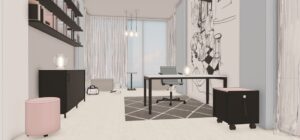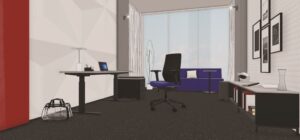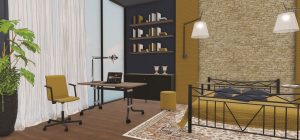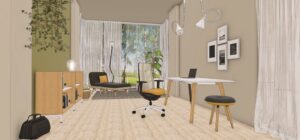Članek s spletne strani König+Neurath
SUCCESSFUL AGILE WORKING AT HOME SOCIAL DISTANCING AND FEELING OKAY
It’s up to us all to slow the spread of the coronavirus so that our health system remains stable and people who might currently need help more than us receive it. By allowing people to work from home, companies are minimising the points of contact, at least for employees who are not responsible for production, sales and logistics. Social distancing can flatten the infection curve. We offer you a few simple tips to help make your home working experience a success.
Everything a workstation needs
It doesn’t matter whether you’re working with a laptop and phone, your employer’s given you a PC or you’re using your own equipment – your workstation needs to meet ergonomic requirements so that everything runs smoothly. Technology is key: a virtual private network like VPN ensures that you can move sensitive data around securely. Digital tools like Office 365 as well as Asana, Trello and Hive, which are online project management tools, help you to keep an eye on the rest of the team. You can use Skype or messenger programs like Slack or Circuit to keep in contact with each other. WeTransfer or Terashare allow you to share large quantities of data as well. Google Drive and Dropbox Let you save documents in a central location so that the whole team has access to them.
Three inspirational ideas from König + Neurath for creating your workstation
• The ideal position for your desk and chair
• How an ergonomic workstation can help you
• What constitutes enough movement?



1. How to set up your new workstation effectively
The ideal position for your screen is side-on to the window. If you sit directly in front of the window, the brightness gradient between daylight and the display is generally too great, and your eyes will get tired. If you have the window behind you, it could cause the monitor to reflect. The correct seat height is worked out like this: with your feet flat on the floor, your thighs and calves should form a 90° angle. The backrest should come up to the point of the shoulder blade. With regard to desk height, the table top should be the same height as the armrests, or one or two centimetres lower. Wrist rests in front of the keyboard take the strain off the shoulders, neck and joints when you type. You can find more information in our article How should I sit at my workstation?
2. What an ergonomic workstation can do for you
Maybe you’ll enjoy working at home, and this home working phase will inspire you to update your equipment. If so, it’s a good idea to make sure that your desk and swivel chair can be adjusted to suit you and allow enough scope for you to move around. You can find a few more ideas on the subject of activity at your desk here: Moving on the job. Ideally you should choose furniture that meets your expectations with regard to home comforts and appropriateness for work. We have several chair ranges that look really attractive and are perfect for the home office, such as PUBLICA, MOVE.ME, MOVE.MIX, K+N BALANCE.CHAIR and the NET.WORK.PLACE Organic Collection. Desks that would work well in your home include LIFE.S, ACTIVE.T, TALO.S and TABLE.T.
3. Sufficient movement – even at home
Have you already noticed that your day at the office incorporates more movement? At the moment, you aren’t doing your route to work or the movement around the office to attend meetings or visit colleagues. In evolutionary terms the body runs smoothly if you walk the equivalent of 14 kilometres per day. Sounds a lot? If you’re not enthusiastically sporty, it’s almost impossible. Nevertheless, sports scientists and doctors recommend walking a minimum of 10 000 steps a day or 8 kilometres. More good guidelines include incorporating at least 20 minutes of high-intensity movement into your routine five times a week as a general rule (cardio, brisk walking, cycling), and getting your pulse really racing once a day. An increasing number of people are using fitness tracker watches, which reminds you every hour that you still need to complete a few more steps to reach your goal. So what can you do now you’re at home? You can stand up or walk around to make phone calls, work standing up, and take specific breaks for movement. Take your kids outside, walk to the shops, and use fitness apps or online yoga programmes, so that you emerge from the crisis fit and
strong!



